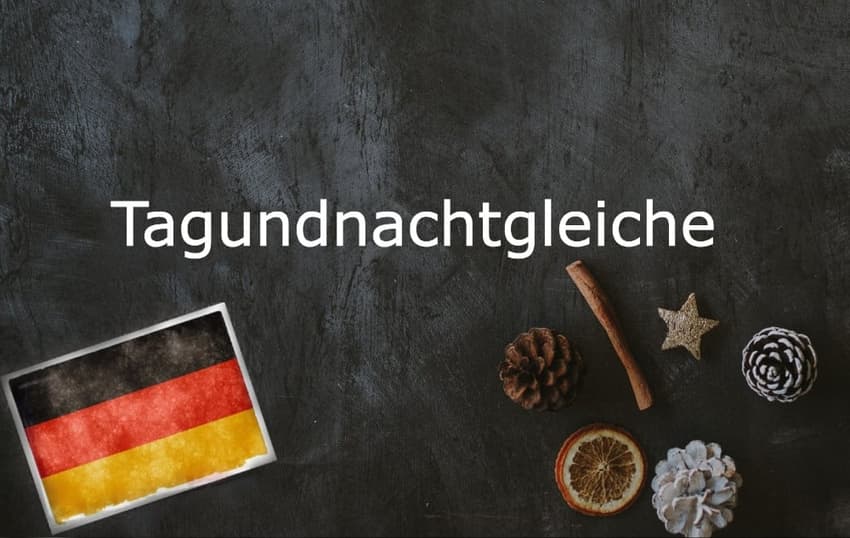German word of the day: Tagundnachtgleiche

This March equinox marks the astronomical beginning of spring in the northern hemisphere, and occurs on the 20th this year. Did you know there are two German terms for this day?
Why do I need to know ‘Tagundnachtgleiche’?
You may hear this word a lot on Wednesday, and then probably not again until the autumnal equinox comes in September.
More of a novel term than one for everyday use, Die Tagundnachtgleiche is one you can use to impress German speakers with your knowledge of heavens and the earth, and your expansive vocabulary.
What does it mean?
Tagundnachtgleiche is the German word for equinox, which is the day when the sun crosses the celestial equator, making the day and night equal in length and also marking a change of seasons.
Alternatively the word Äquinoktium is also used for equinox.
Each year contains two equinoxes: a spring equinox (Frühlings-Tagundnachtgleiche or Frühjahrs-Tagundnachtgleiche) and a fall equinox (Herbst-Tagundnachtgleiche).
The spring equinox, which falls on March 20th this year, marks the beginning of spring. From this day forward, daylight hours in the northern hemisphere will continue getting longer until the summer solstice.
READ ALSO: Seven signs that spring has arrived in Germany
The word equinox comes from Latin and literally means “equal night”, meaning that the night is equal to the day (or more specifically that the hours of darkness are equal to the hours of daylight.)
In this case, the German term leaves nothing to be deduced. The word is a short phrase put together – Tag und Nacht Gleiche – meaning “day and night equality”.
Equinox traditions
The Spring Equinox and the beginning of the spring season is cause for celebration in cultures around the world, and is often linked with traditions related to rebirth, renewal and fertility.
Among pre-Christian Germanic tribes such as the Saxons, a spring Goddess called Ostara, was celebrated on the Spring Equinox with a feast day and other traditions such as planting seeds or decorating eggs. Traditional symbols for Ostara included rabbits and ducklings.
It is widely believed that some of these traditions were later adopted and Catholicised, leading to the creation of Easter (Ostern) as we know it today.
Use it like this:
In diesem Jahr findet die Frühlings-Tagundnachtgleiche zwischen dem 19. und 20. März statt.
This year the spring equinox is between March 19th and 20th.
Glückliche Tagundnachtgleiche!
Happy equinox!
Comments
See Also
Why do I need to know ‘Tagundnachtgleiche’?
You may hear this word a lot on Wednesday, and then probably not again until the autumnal equinox comes in September.
More of a novel term than one for everyday use, Die Tagundnachtgleiche is one you can use to impress German speakers with your knowledge of heavens and the earth, and your expansive vocabulary.
What does it mean?
Tagundnachtgleiche is the German word for equinox, which is the day when the sun crosses the celestial equator, making the day and night equal in length and also marking a change of seasons.
Alternatively the word Äquinoktium is also used for equinox.
Each year contains two equinoxes: a spring equinox (Frühlings-Tagundnachtgleiche or Frühjahrs-Tagundnachtgleiche) and a fall equinox (Herbst-Tagundnachtgleiche).
The spring equinox, which falls on March 20th this year, marks the beginning of spring. From this day forward, daylight hours in the northern hemisphere will continue getting longer until the summer solstice.
READ ALSO: Seven signs that spring has arrived in Germany
The word equinox comes from Latin and literally means “equal night”, meaning that the night is equal to the day (or more specifically that the hours of darkness are equal to the hours of daylight.)
In this case, the German term leaves nothing to be deduced. The word is a short phrase put together – Tag und Nacht Gleiche – meaning “day and night equality”.
Equinox traditions
The Spring Equinox and the beginning of the spring season is cause for celebration in cultures around the world, and is often linked with traditions related to rebirth, renewal and fertility.
Among pre-Christian Germanic tribes such as the Saxons, a spring Goddess called Ostara, was celebrated on the Spring Equinox with a feast day and other traditions such as planting seeds or decorating eggs. Traditional symbols for Ostara included rabbits and ducklings.
It is widely believed that some of these traditions were later adopted and Catholicised, leading to the creation of Easter (Ostern) as we know it today.
Use it like this:
In diesem Jahr findet die Frühlings-Tagundnachtgleiche zwischen dem 19. und 20. März statt.
This year the spring equinox is between March 19th and 20th.
Glückliche Tagundnachtgleiche!
Happy equinox!
Join the conversation in our comments section below. Share your own views and experience and if you have a question or suggestion for our journalists then email us at [email protected].
Please keep comments civil, constructive and on topic – and make sure to read our terms of use before getting involved.
Please log in here to leave a comment.